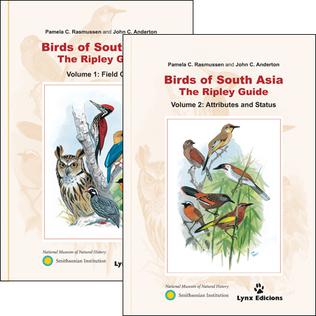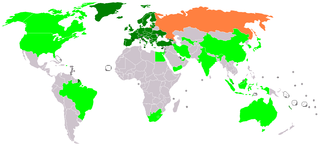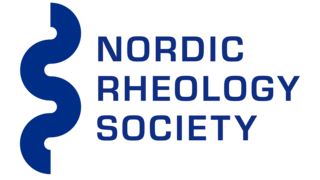
CITES is a multilateral treaty to protect endangered plants and animals. It was drafted as a result of a resolution adopted in 1963 at a meeting of members of the International Union for Conservation of Nature (IUCN). The convention was opened for signature in 1973 and CITES entered into force on 1 July 1975.
The Bern Convention on the Conservation of European Wildlife and Natural Habitats, also known as the Bern Convention, is a binding international legal instrument in the field of Nature Conservation, it covers the natural heritage in Europe, as well as in some African countries. The Convention was open for signature on 19 September 1979 and came into force on 1 June 1982. It is particularly concerned about protecting natural habitats and endangered species, including migratory species.
The British Ornithologists' Union (BOU) aims to encourage the study of birds ("ornithology") and around the world, in order to understand their biology and to aid their conservation. The BOU was founded in 1858 by Professor Alfred Newton, Henry Baker Tristram and other scientists. Its quarterly journal, Ibis, has been published continuously since 1859.

The Fea's petrel, is a small seabird in the gadfly petrel genus, Pterodroma. It was previously considered to be a subspecies of the soft-plumaged petrel, but they are actually not closely related at all. However, P. feae is very closely related to Zino's petrel and Desertas petrel, two other species recently split from P. mollis. The gadfly petrels are named for their speedy weaving flight, as if evading horseflies. The flight action is also reflected in the genus name Pterodroma, from Ancient Greek pteron, "wing" and dromos, " runner". This species is named after the Italian zoologist Leonardo Fea (1852-1903).

Zino's petrel or freira is a species of small seabird in the gadfly petrel genus, endemic to the island of Madeira. This long-winged petrel has a grey back and wings, with a dark "W" marking across the wings, and a grey upper tail. The undersides of the wings are blackish apart from a triangle of white at the front edge near the body, and the belly is white with grey flanks. It is very similar in appearance to the slightly larger Fea's petrel, and separating these two Macaronesian species at sea is very challenging. It was formerly considered to be a subspecies of the soft-plumaged petrel, P. mollis, but they are not closely related, and Zino's was raised to the status of a species because of differences in morphology, calls, breeding behaviour and mitochondrial DNA. It is Europe's most endangered seabird, with breeding areas restricted to a few ledges high in the central mountains of Madeira.

A National Olympic Committee (NOC) is a national constituent of the worldwide Olympic movement. Subject to the controls of the International Olympic Committee, NOCs are responsible for organizing their people's participation in the Olympic Games. They may nominate cities within their respective areas as candidates for future Olympic Games. NOCs also promote the development of athletes and training of coaches and officials at a national level within their geographies.
AERC may refer to one of the following.
Erasmus Student Network (ESN) is a Europe-wide student organisation.

The Madeira firecrest, Madeira kinglet, or Madeiracrest is a very small passerine bird endemic to the island of Madeira. It is a member of the kinglet family. Before it was recognised as a separate species in 2003, it was classified as a subspecies of the common firecrest. It differs in appearance and vocalisations from its relative, and genetic analysis has confirmed it as a different species. The Madeiran bird has green upperparts, whitish underparts and two white wingbars, and a distinctive head pattern with a black eye stripe, short white supercilium, and a crest that is mainly orange in the male and yellow in the female.

The Western Palaearctic or Western Palearctic is part of the Palaearctic realm, one of the eight biogeographic realms dividing the Earth's surface. Because of its size, the Palaearctic is often divided for convenience into two, with Europe, North Africa, northern and central parts of the Arabian Peninsula, and part of temperate Asia, roughly to the Ural Mountains forming the western zone, and the rest of temperate Asia becoming the Eastern Palaearctic. Its exact boundaries differ depending on the authority in question, but the Handbook of the Birds of Europe, the Middle East, and North Africa: The Birds of the Western Palearctic (BWP) definition is widely used, and is followed by the most popular Western Palearctic checklist, that of the Association of European Rarities Committees (AERC). The Western Palearctic realm includes mostly boreal and temperate climate ecoregions.
A bird rarities committee or bird records committee is a committee which exists to validate records of rare birds in a particular country or region.

Birds of South Asia: The Ripley Guide by Pamela C. Rasmussen and John C. Anderton is a two-volume ornithological handbook, covering the birds of South Asia, published in 2005 by the Smithsonian Institution and Lynx Edicions. The geographical scope of the book covers India, Bangladesh, Pakistan, Sri Lanka, Nepal, Bhutan, Maldives, the Chagos Archipelago and Afghanistan. In total, 1508 species are covered. Two notable aspects of Birds of South Asia are its distribution evidence-base — the book's authors based their distributional information almost completely on museum specimens — and its taxonomic approach, involving a large number of species-level splits.

ETSI is an independent, not-for-profit, standardization organization in the field of information and communications. ETSI supports the development and testing of global technical standards for ICT-enabled systems, applications and services.

The Gower Ornithological Society is a society for professional and amateur birdwatchers covering the geographical areas of south Wales comprising Gower, Swansea, Neath and Port Talbot.

Regulus is a genus of bird in the family Regulidae.

British Octopush Association (BOA) is the governing body for underwater hockey in the United Kingdom (UK).
Colin Bradshaw is an English physician and ornithologist who was chairman of the British Birds Rarities Committee from 1997 to 2008. He was active in the BBRC for almost 20 years, both as a committee member and as chairman. He is a medical doctor by profession and travels extensively for birding, and among his other hobbies are guitar, cricket, and photography.
The International Economic Association (IEA) is an NGO established in 1950, at the instigation of the Social Sciences Department of UNESCO. To date, the IEA still shares information and maintains consultative relations with UNESCO. In 1973 the IEA became a federated member of the International Social Science Council.

The Nordic Rheology Society (NRS) is a professional organization that promotes and propagates rheology in the Nordic countries and beyond. The NRS provides a forum for academic and industrial researchers to discuss their ideas and to present their research.











